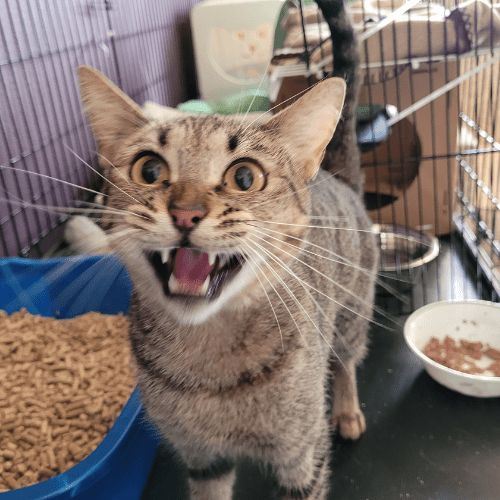
How to Tame a Feral Cat: A Step-by-Step Guide
Are you trying to learn how to tame a feral cat but not sure where to start? Fear not! Our comprehensive step-by-step guide is here to help you through how to socialize a feral cat. From understanding the nature of feral cats to preparing them for adoption, we’ll cover everything you need to know to transform a wild feline into a loving companion.
Key Takeaways
- Feral cats or kittens can be socialized with patience, consistency, and positive reinforcement.
- Build trust by providing a safe environment, offering treats, and engaging in playful interactions.
- Monitor progress to successfully transition them into their forever home!
Understanding Feral Cats and Kittens
Feral cats are essentially “wild animals” that have adapted to living independently from humans. Socializing these free-roaming cats, particularly feral kittens, is possible if you start at a young age. The key is to provide a comfortable and secure environment for them and dedicate time to work with them regularly.
Patience and consistency are paramount since older feral cats or frightened kittens may require additional socializing time and effort.
One way to build trust with feral kittens and cats is through food and positive associations. Here are some steps you can take:
- Use treats like Churu treats or wet food to reward the cat for getting close to you.
- Introduce new experiences during meal times, such as reading to them or having background human voices.
- Gradually expand their comfort zone by being present during their meal times and creating positive associations with your presence.
By following these steps, you can build trust with feral kittens and help them become more comfortable around you.

When it comes to handling and physically contacting feral cats and kittens, always approach them gently. A towel can be used to cover the kitten, providing a sense of security during the first physical contact. Remember to speak softly and avoid making any sudden movements that might startle the kitten.
Assessing a Feral Cat’s Fear Level
A feral cat’s confidence level is influenced by their background, experiences with humans, and genetics. Evaluating their fear level is necessary to determine the most effective socialization strategy. An aggressive kitten may require more time and patience to socialize, especially when dealing with exceptionally skittish kittens. In contrast, a less aggressive kitten might be more receptive to socialization efforts.
Positive experiences with humans can help improve a feral cat’s confidence level. When handling a kitten, always choose the least aggressive one and approach them from behind to avoid startling them. Proper handling techniques, like supporting the hind legs and holding the kitten by the nape of the neck, can make them feel safe and loved.
For the well-being of feral kittens, daily handling and maintaining clean, well-stocked food and water bowls are crucial. This routine not only helps in their physical development but also assists in building trust and familiarity with humans.

Creating a Safe Environment for Socialization
Creating a safe and comfortable space for taming kittens or feral is the first exciting responsibility after rescuing them. Using a collapsible kennel or a large pet carrier can provide a secure and cozy environment for the cat, especially if you need to treat a flea infestation.
Kittenproofing the room and providing essentials like food, water, and a litter box will help the kittens feel safe and confident to explore. Introducing other human voices and sounds can also help them become more comfortable with their new surroundings.
A “sanctuary space” can be created to provide feral cats with a sense of security and comfort. This space should include hiding places, cat trees, towers, scratching posts, and bedding. Additionally, maintaining a calm atmosphere by speaking in a low, soothing voice and moving slowly around the cat will help make them feel at ease.

When feral kittens from the same litter graduate to a larger space at just a few weeks of age, especially older kittens, it’s important to meet their basic needs and foster an environment that promotes comfort, handling, and transition to their new life.
Building Trust Through Food and Positive Interactions
Using food and positive associations is an effective way to build trust with feral cats. Offering special treats, like a Churu or even cat-friendly baby food, can help them overcome their fear barriers and expand their comfort zone. Ensure that you introduce new treats and experiences gradually, respecting the kitten’s comfort zone.
Another way to connect with a feral kitten is through playtime. Using lightweight cat toys or “kitty tease” toys can provide fun and engaging interaction. Speaking in comforting and encouraging tones during playtime can help the kitten feel secure and foster a strong bond.
In addition to treats and playtime, using a soft pet brush can help build trust with a feral kitten, as the soft pet brush imitates the sensation of being groomed by another cat. Remember to avoid making eye contact so the kitten remains calm, as it can be intimidating to the kitten, and instead, show submissive behavior by lowering your head occasionally.

Handling and Physical Contact
Care and patience are required when initiating physical contact with a feral kitten or cat. Using a towel or taming wand can provide a sense of security and help the cat become familiar with your presence. Always move your hands below chin level to avoid startling the cat and make them feel safe.
Gradually progress to gently picking up the cat and holding them securely in your arms or holding them on your lap. Speak softly, and avoid making sudden movements that might scare them. Consistent, gentle handling will help the cat become more comfortable with human contact and foster a strong bond.
As the cat or feral kittens grow more comfortable with you, introducing them to other humans and pets becomes necessary. This will help them adjust to new environments and social situations, ensuring a successful transition to their new life.

Playtime and Interaction
Building trust and familiarity with a cat hinges on active engagement in playtime and interaction. Using appropriate toys like lightweight cat toys or wand toys can provide fun and engaging playtime. Spend at least two hours a day with a feral kitten or cat, being patient and persistent in your efforts to socialize them.
During playtime, follow these tips to create a calming atmosphere and ensure a positive experience for your cat:
- Speak in a low, soothing voice.
- Move slowly around the cat.
- Allow the cat to take the lead and enjoy playtime at its own pace.
- Respect their boundaries and never force interaction.
Consistent playtime and interaction will help a feral cat become more comfortable with their new surroundings and prepare them for a successful transition to a loving home.
Exposure to Other Humans and Pets
The socialization process for the feral cat necessitates their gradual introduction to other humans and pets. Start by introducing them from a distance, allowing the cat to observe and become familiar with their presence. Gradually move closer, offering treats to help the cat associate other humans and pets with pleasant experiences.
Socializing with other pets can help cats become more comfortable and confident in their new environment and teach them how to interact with other animals. Be patient and persistent in your efforts to socialize the cat with other pets, giving them time to adjust to their new environment and gradually introducing them to new experiences.
Exposure to other humans and pets will not only help a feral cat adjust to new environments but also ensure successful adoption and transition to their new home, as cats tend to adapt better with proper socialization.
Monitoring Progress and Overcoming Setbacks
While working with a feral cat, keeping track of their progress and celebrating minor victories is essential. Here are some ways to do that:
- Regularly update photos, records of health, and behavioral notes.
- Track their progress and development with a journal.
- Celebrate each milestone of taming your feral cat!
Setbacks may occur during the socialization process. If a feral cat regresses or becomes fearful, return to previous steps and try again later. Be patient and persistent in your efforts, as most cats can make progress with time and dedication.
Monitoring progress and overcoming setbacks are essential aspects of the socialization process. By being attentive to the feral cat’s needs and adjusting your approach as needed, you can help them successfully transition to a loving home.

Preparing for Adoption
Before preparing a feral cat for adoption, it is crucial to ensure they are comfortable with handling and human contact. In other words, they aren’t feral any more. It’s also important to take the cat to the veterinarian for a full checkup, vaccinations and spaying or neutering will help ensure a successful adoption. You should also have the cat microchipped while at the vet.
Informing the adoptive family of the cat’s background and any special needs they may have is crucial for a smooth transition to their new home. With proper care, socialization, and patience, feral cats can become loving companions in their new forever homes.
Summary
Taming a feral cat may be a challenging yet rewarding journey. By understanding their nature, assessing their fear level, creating a safe environment, building trust through food and positive associations, introducing handling and physical contact, engaging in playtime and interaction, exposing them to other humans and pets, monitoring progress, and preparing them for adoption, you can help transform a wild feline into a loving companion. You can give a feral cat a chance at a new life with patience, persistence, and love!



